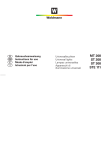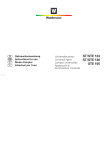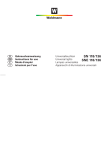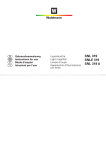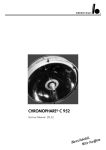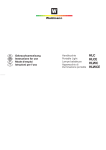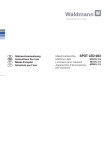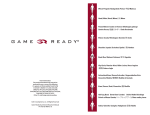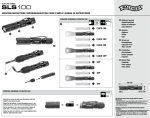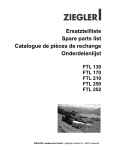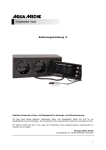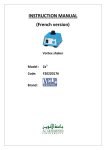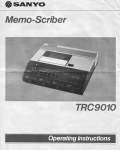Download W-GA AVL/FGL/LX/RLL 4s
Transcript
Waldmann D GB F I Gebrauchsanweisung Instructions for use Mode d‘emploi Istruzioni per l‘uso Modelle Models Modèles Modelli AVL 122 N FGL 111/118 LX 111 RLL 122/122 T AVL / FGL / LX / RLL Waldmann Fig. 1a Fig. 1b Fig. 1c RLL 122 T FGL 118 LX 111 Original D Gebrauchsanweisung 4 Translations Fig. 1d AVL 122 N 2 GB Instructions for use 7 F Mode d‘emploi 10 I Istruzioni per l‘uso 13 AVL / FGL / LX / RLL Waldmann Fig. 2a Fig. 2b/c RLL 122 T FGL / LX Fig. 2d 15° Fig.3 15° AVL 122 N 3 Gebrauchsanweisung AVL / FGL / LX / RLL D Waldmann Allgemeines Bestimmungsgemäßer Gebrauch: Verwendungszweck: Arbeitsplatzleuchte mit integrierter Lupe oder Ventilator - Arbeitsplatzleuchten sind Leuchten für die Einzelplatzbeleuchtung und werden zusätzlich zu einer allgemeinen Beleuchtung verwendet Montage Sicherheitshinweise : Abkürzungen und Symbole: Die Leuchte darf nur in trockenen und nicht explosionsgefährdeten Räumen betrieben werden! Achtung, Begleitpapiere beachten! Bei Nichtbenutzung die Lupe gegen Sonneneinstrahlung abdecken. Brandgefahr! Schutzleiteranschluss (Gerät der Schutzklasse I) Gerät der Schutzklasse II (Schutzisolation) Einsatzort: Ausschließlich für trockene und nicht explosionsgefährdete Räume. Wechselstrom Die Leuchte muss mittels Tischklemme oder Tischfuß standsicher an der Arbeitsfläche positioniert werden. Die Befestigungslöcher am Federfußgelenk werden zugänglich, indem man die Befestigungsplatte (3) um 45° dreht. Hinweis: Styropor im Leuchtenkörper dient der Transportsicherung der Lampe und kann entfernt werden. AUS (Lampenstromkreis) Betriebsart: Die Leuchte ist ausgelegt für Dauerbetrieb. EIN (Lampenstromkreis) Inbetriebnahme Brandgefahr! DVE Der Hersteller kann nicht für Schäden verantwortlich gemacht werden, die infolge der Nutzung abweichend vom bestimmungsgemäßen Gebrauch, oder der Nichtbeachtung von Sicherheitshinweisen und Warnungen, verursacht werden. 4 VDE-Zulassung CEKonformitätskennzeichen Vor Inbetriebnahme ist zu überprüfen, ob die Anschlussspannung mit der auf dem Leistungsschild angegebenen Nennspannung übereinstimmt. Gebrauchsanweisung AVL / FGL / LX / RLL Ein- und Ausschalten des Leuchtmittels Mit dem Schalter, oben auf dem Reflektorgehäuse, wird die Lampe ein- und ausgeschaltet. Ein- und Ausschalten des Ventilators (nur bei Leuchte AVL) Mit dem Schalter, oben auf der Ventilatorabdeckung wird der Ventilator ein- und ausgeschaltet. D Nachstellen der Gelenke Die Gelenke sind mittels einer Verstellschraube einstellbar. Jedes Gelenk wird so eingestellt, dass die Leuchte einerseits leicht beweglich ist, andererseits aber das Gelenk in der gewünschten Einstellung verharrt. Die Leuchte ist somit fixiert. Vorsicht! Das Fußgelenk darf nur festgestellt oder leicht gelöst werden, ansonsten hängt die Entlastungsfeder aus und muss werkseitig wieder eingestellt werden. Tischfüße 190 036 oder 190 037 Einstellen der Feder bei Federgelenk-Leuchten Lampen- und Starterwechsel a) Leuchte bis zum Anschlag nach hinten kippen. b) Die Flügelmutter (1) etwa 3-4 Umdrehungen lösen. c) Die Flügelmutter (1) nach innen drücken, bis die gegenüberliegende Stellscheibe (2) aus dem Haltestift rastet. d) Stellscheibe (2) mit einem flachen Gegenstand (auch große Münze) zum Spannen der Feder nach links drehen. e) Stellscheibe (2) nach Erreichen der gewünschten Spannung durch kurzes Vor- und Rückdrehen zum Einrasten in den Haltestift bringen. Dabei die Flügelmutter (1) leicht anziehen. f) Flügelmutter (1) bis zur erforderlichen Bremswirkung anziehen. Bei den Leuchten AVL und RLL: Siehe Fig. 2d und 2a auf Seite 3. Nach Lösen der Befestigungsschrauben für die Blende, kann diese abgenommen werden. Die Leuchtstofflampe und der Starter sind jetzt zugänglich (siehe Fig. 2a und 2b). Bei den Leuchten FGL, LX: Siehe Fig. 2b/c auf Seite 3. Den Schraubendreher in die Aussparungen zwischen dem Reflektorgehäuse und der Blende stecken und nach oben drücken. Die Leuchtstofflampe in Längsrichtung aus der Lampenfassung ziehen. 1 15° 2 15° Achtung: Bei der Verwendung dieser Tischfüße dürfen die Leuchten nur um ca. 15 ° aus der Mittelstellung gedreht werden. Es besteht sonst Kippgefahr! Waldmann 3 5 Gebrauchsanweisung AVL / FGL / LX / RLL Auswechseln des Filters am Ventilator (nur bei Leuchte AVL) Abnehmen der Blende durch Lösen der Befestigungsschrauben. Durch leichtes Eindrücken an den Befestigungspunkten der Filterabdeckung, kann diese samt Filter herausgenommen und wieder eingesetzt werden. Vorsicht! Der Ventilator muss hierzu ausgeschaltet sein. D Waldmann Wartung Technische Daten Vor Wartungs- und Reparaturarbeiten ist die Leuchte vom Netz zu trennen! Die Arbeiten dürfen nur von einem ausgebildeten Elektro-Fachmann durchgeführt werden! Leuchte AVL 122 N Abmessungen Leuchtenkörper ∅ 247 mm Lampenbestückung Ring-LS-Lampe 22 W Leuchte FGL 111/118 Reinigung Zur Reinigung der Leuchtenteile verwenden Sie ein mit normalem Haushaltsreiniger getränktes Tuch. Beachten Sie bei den verwendeten Mitteln die Verträglichkeit mit Lacken und Kunststoffen. Abmessungen Leuchtenkörp. 270 x 67 x 52 mm Lampenbestückung Komp.-LS-Lampe 11 W (FGL 111) Komp.-LS-Lampe 18 W (FGL 118) Leuchte LX 111 Abmessungen Leuchtenkörp. 270 x 67 x 52 mm Lampenbestückung Kompakt-LS-Lampe 11 W Leuchte RLL 122/122T Entsorgung Die Leuchte muss nach Ende der Lebensdauer, entsprechend den örtlichen Vorschriften, entsorgt werden. Defekte Leuchtstofflampen müssen als Sondermüll entsorgt werden. 6 Abmessungen Leuchtenkörper ∅ 245 mm Lampenbestückung Ring-LS-Lampe 22 W Instructions for use AVL / FGL / LX / RLL GB Waldmann Installation General information Designated use: Intended purpose: Work place light with integrated magnifying glass or with ventilator - Work place lights are lights for single workplaces and are used in addition to the ambient room lighting system. Safety instructions: Abbreviations and symbols: The light may only be operated in dry rooms not subject to explosion hazards! Attention: observe accompanying documents! When not in use, cover the magnifier against solar radiation. Risk of fire! Protective earthing (Device of protection class I) Device of protection class II (protective insulation) Place of use: Only in dry rooms not subject to the risk of explosion. Note: Polystyrene in the light body is used for transport safety of the lamp and can be removed. Alternating current Operating mode: The light is designed for continuous operation. OFF (lamp circuit) ON (lamp circuit) Risk of fire! DVE The manufacturer cannot be held liable for damage caused by using the device for purposes other than the designated use or by ignoring safety instructions and warnings. The light must be positioned firmly and stably on the work surface using the desk clamp or table base. You can gain access to the mounting holes on the spring-balanced base by turning the mounting plate (3) through 45 °. Putting into operation Before putting the light into operation, check that the connection voltage corresponds to the rated voltage specified on the rating plate. VDE Approval CEconformity mark 7 Instructions for use AVL / FGL / LX / RLL GB Waldmann Switching the lamp on and off Readjusting the articulation joints Adjusting the spring on spring-balanced lights Changing the lamp and starter unit The lamp can be switched on and off at the switch on the top of the reflector housing. The articulation joints can be adjusted by means of an adjusting screw. Each articulation joint must be adjusted so that the light is easy to move on the one hand but so that the articulation joint remains in the required position on the other. This fixes the light in position. a) Tilt the light fully back. b) Slacken the wing nut (1) approx. 3-4 turns. c) Push the wing nut (1) in until the opposite adjusting disk (2) disengages from the retaining pin. d) Turn the adjusting disk (2) with a flat implement (or a large coin) to the left in order to cock the spring. e) When the required tension has been reached, engage the adjusting disk (2) into the retaining pin by turning it briefly forwards and backwards until it engages in position. Lightly tighten the wing nut (1) when doing this. f) Tighten the wing nut (1) until the required breaking effect is achieved. On lights AVL and RLL: See fig. 2d and 2a on page 3. Undo the securing screws for the cover and you can then detach the cover. You will now have access to the fluorescent lamp and the starter unit. Switching the ventilator on and off (only on light AVL) The ventilator can be switched on and off at the switch on the top of the ventilator cover. Caution! The base articulation joint may only be locked or slackened lightly. Otherwise, the relief spring will be disengaged and must be set again at the works. 8 15° 15° Important: If using these table bases, the light may be turned only through approx. 15 ° from centre position. Otherwise there is a risk of the light tipping over! 1 2 Table bases 190 036 or 190 037 3 On lights FGL, LX, SNL: See fig. 2b/c on page 3. Insert the screwdriver into the recesses between the reflector housing and the cover and push it up. Pull the fluorescent lamp lengthwise out of the lamp socket. Instructions for use AVL / FGL / LX / RLL Changing the filter on the ventilator (only on light AVL) Detach the cover by undoing the securing screws. By pressing in lightly at the securing points of the filter cover, you can detach the filter cover, together with the filter, and refit it. Caution! Switch off the ventilator before doing this. GB Waldmann Maintenance Technical data Disconnect the light from the electrical power supply before carrying out maintenance or repair work! This work may be carried out only by a qualified electrician! Light AVL 122 N Dimensions Light body ∅ 247 mm Lamp complement Circular fluorescent lamp 22 W Light FGL 111/118 Cleaning Please use a cloth and normal domestic cleaning agent to clean the light components. Please ensure that the cleaning agents which you use are compatible with paints and plastics. Dimensions Light body 270 x 67 x 52 mm Lamp complement Comp. fluor. lamp 11 W (FGL 111) Comp. fluor. lamp 18 W (FGL 118) Light LX 111 Dimensions Light body 270 x 67 x 52 mm Lamp complement Compact fluorescent lamp 11 W Light RLL 122/122T Waste disposal When it reaches the end of its service life, the light must be disposed of in accordance with local regulations. Dimensions Light body ∅ 245 mm Lamp complement Circular fluorescent lamp 22 W Defective fluorescent lamps must be disposed of as hazardous waste. 9 Mode d‘employ AVL / FGL / LX / RLL F Waldmann Montage Généralités Utilisation conforme à l’emploi prévu : Application : Luminaire pour poste de travail avec loupe ou avec ventilateur - Les luminaires pour poste de travail sont des luminaires destinés à l‘éclairage d‘un poste de travail individuel et sont utilisés en complément de l‘éclairage général. Consignes de sécurité : Abréviations et symboles : Le luminaire ne doit être utilisé que dans des locaux secs et exempts de risques d’explosion ! Attention, tenir compte des documents d’accompagnement ! Lorsque le luminaire n’est pas utilisé, protéger la loupe contre le rayonnement solaire en la couvrant. Risque d’incendie ! Raccordement avec fil de terre (Appareil de la classe de protection I) Appareil de la classe de protection II (double isolation) Lieu d’application : Le luminaire ne doit être utilisé que dans des pièces sèches et exemptes de risques d’explosion. ARRÊT (circuit lampe) MARCHE (circuit lampe) Risque d’incendie ! DVE 10 Remarque: le polystyrène dans le corps de lampe sert à protéger la lampe pendant le transport et peut être enlevé. Courant alternatif Type de fonctionnement : Le luminaire est conçu pour le fonctionnement en service continu. Le fabricant décline toute responsabilité concernant les dommages qui résulteraient d’une utilisation non conforme à l’emploi prévu ou du non-respect des consignes de sécurité et des avertissements. La lampe doit être positionée de façon stable sur le plan de travail au moyen d‘une pince ou d‘un socle de table. Les trous de fixation sur l‘articulation de pied à ressort sont accessibles en tournant la plaque de fixation (3) en 45°. Homologation VDE Sigle de conformité CE Mise en service Avant la mise en service, il est nécessaire de vérifier que la tension d‘alimentation correspond à la tension nominale indiquée sur la plaquette signalétique. Mode d‘employ AVL / FGL / LX / RLL Allumage et extinction de la lampe La lampe s‘allume et s‘éteint au moyen de l‘interrupteur situé sur le dessus du boîtier de réflecteur. Mise en marche et arrêt du ventilateur (luminaire AVL seulement) Le ventilateur se met en marche et s´arrête par l‘interrupteur situé sur le couvercle de ventilateur. F Waldmann Réglage des articulations Les articulations sont réglables à l‘aide d‘une vis de réglage. Régler chaque articulation de façon que la lampe soit facile à déplacer tout en étant suffisamment résistante pour être immobilisée dans la position voulue. Attention! L‘articulation de pied doit être seulement bloquée ou légèrement desserrée, sinon le ressort se décroche et la lampe devra être retournée en usine pour réglage. Pour les luminaires AVL et RLL: Voir fig. 2d et 2a de page 3. Retirer le diffuseur après avoir desserré ses vis de fixation. Le tube fluorescent et le starter sont à présent accessibles. Pour les luminaires FGL, LX: Voir fig. 2b/c de page 3. Introduire un tournevis dans les évidements entre le boîtier de réflecteur et le diffuseur et faire levier vers le haut. Retirer le tube fluorescent de la douille dans le sens de la longueur. Fig. 4 1 2 15° Attention: en cas d‘utilisation de ce socle de table, le luminaire ne doit pas être tournée de plus de 15° de part et d‘autre de la position centrale. Sinon, il y a risque de basculement! Voir fig. 4 a) Basculer le luminaire vers l‘arrière jusqu‘en butée. b) Desserrer l‘écrou papillon (1) d‘environ 3-4 tours. c) Posser l‘écrou papillon (1) vers l‘intérieur jusqu‘à ce que le disque de réglage (2) soit dégagé de la goupille de retenue. d) Tourner le disque de réglage (2 vers la gauche avec un objet plat (ou une pièce de monnaie) pour tendre le ressort. e) Lorsque la tension souhaitée est atteinte, engager le disque de réglage (2) dans la goupille de retenue par une brève rotation en avant et en arrière. Ce faisant, serrer légèrement l‘écrou papillon (1). f) Serrer l‘écrou papillon (1) jusqu‘à l‘effet de freinage nécessaire. Remplacement du tube et du starter 15° Socle de table 190 036 003 Réglage du ressort sur les luminaires à articulation à ressort 3 11 Mode d‘employ AVL / FGL / LX / RLL Remplacement du filtre de ventilateur (luminaire AVL seulement) Retirer le diffuseur en desserrant ses vis de fixation. Une légère pression exercée sur les points de fixation du couvercle de filtre permet de le retirer avec le filtre, puis de le remettre en place. Attention: Le ventilateur doit être hors tension. F Waldmann Maintenance Caractéristiques techniques Déconnecter le luminaire du secteur avant toute opération de maintenance ou de réparation. Les travaux ne doivent être effectués que par un électricien qualifié. Luminaire AVL 122 N Dimensions Corps de lampe Equipement Tube fluo circulaire ∅ 247 mm 22 W Luminaire FGL 111/118 Nettoyage Le luminaire se nettoie à l‘aide d‘un chiffon imbibé d‘un produit ménager usuel. Assurez-vous que les produits utilisés sont compatibles avec les laques et les plastiques. Dimensions Corps de lampe270 x 67 x 52 mm Equipement Tube fluo compact 11 W (FGL 111) Tube fluo compact 18 W (FGL 118) Luminaire LX 111 Dimensions Corps de lampe270 x 67 x 52 mm Equipement Tube fluo compact 11 W Luminaire RLL 122/122T Elimination Au terme de sa durée de vie, l‘appareil doit être éliminé conformément aux dispositions locales. Les tubes fluorescents défectueux doivent être éliminés en tant que déchets spéciaux. 12 Dimensions Corps de lampe Equipement Tube fluo circulaire ∅ 245 mm 22 W Istruzioni per l’uso AVL / FGL / LX / RLL I Waldmann Informazioni generali Uso conforme allo scopo d’impiego previsto: Scopo d’impiego: Apparecchio illuminante per posto di lavoro con lente integrata o con ventilatore - Apparecchi per posti di lavoro sono destinati per un posto di lavoro singolo e sono utilizzati in aggiunta ad una illuminazione generale. Luogo d’impiego: Esclusivamente per locali asciutti e non soggetti a pericolo d’esplosione. Montaggio Avvertenze per la sicurezza: Abbreviazioni e simboli: Attenzione, osservare la documentazione in dotazione! La lampada deve essere utilizzata esclusivamente in locali asciutti e non soggetti a pericolo d’esplosione! Conduttore di protezione (Apparecchio della classe di protezione I) Se non viene utilizzata, proteggere la lente dall’esposizione ai raggi solari. Pericolo di incendio! Apparecchio della classe di protezione II (Isolamento di protezione) Corrente alternata Avvertenza: il polistirolo nel corpo dell’apparecchio ha soltanto una funzione di protezione durante il trasporto e va quindi tolto. OFF (circuito elettrico della lampada) Tipo di funzionamento: L’apparecchio d’illuminazione è predisposto al funzionamento continuo. ON (circuito elettrico della lampada) Pericolo di incendio! Il fabbricante non può rispondere di danni causati da un utilizzo non conforme allo scopo d’impiego previsto o della mancata osservanza delle avvertenze di sicurezza e degli avvertimenti. L’apparecchio va fissato in maniera stabile al piano di lavoro per mezzo di un morsetto da tavolo o di un’apposita base. I fori per il fissaggio dell’apparecchio, situati nello snodo a molla della base, sono accessibili ruotando la piastra di fissaggio (3) di 45°. DVE Messa in funzione Prima della messa in funzione occorre verificare che la tensione di allacciamento coincida con la tensione nominale indicata sulla targhetta del consumo dell’apparecchio. Omologazione VDE CE-Contrassegno di conformità 13 Istruzioni per l’uso AVL / FGL / LX / RLL Accensione e spegnimento dell’apparecchio La lampada può essere accesa o spenta per mezzo dell’interruttore situato sul portariflettore Accensione e spegnimento del ventilatore (solo per il modello AVL) Il ventilatore si accende e si spegne con l’interruttore sulla copertura in alto. I Waldmann Regolazione degli snodi Gli snodi sono muniti di una vite regolabile che ne permette il fissaggio. In questo modo, se da un lato viene garantita la perfetta movibilità della lampada, dall’altro lo snodo viene bloccato nella posizione desiderata permettendo di mantenere l’apparecchio in una posizione fissa. Attenzione: lo snodo della base deve essere fisso e può essere allentato solo leggermente, per evitare che la molla di compensazione esca dalla sua sede e debba quindi essere nuovamente regolata dal costruttore. Vedi fig. 4 a) Ribaltare la lampada all’indietro fino all’arresto. b) Allentare il dado ad alette (1) di 3-4 rotazioni ca. c) Premere il dado ad alette (1) verso l’interno finché la rosetta di regolazione (2) di fronte esce dalla spina di fissaggio. d) Ruotare la rosetta di regolazione (2) verso sinistra con un oggetto piatto (p. es. una moneta grossa) per tendere la molla. e) Una volta raggiunto il grado di tensione desiderato, ruotare la rosetta (2) nelle due direzioni fino all’arresto nella spina di fissaggio, serrando leggermente il dado ad alette (1). f) Serrare il dado ad alette (1) finché non si è raggiunto l’effetto di arresto desiderato. Modelli AVL e RLL: Vedi fig 2d e 2a de pagina 3. Per rendere accessibili il tubo fluorescente e il relè di accensione, svitare le viti di fissaggio dello schermo e smontarlo. Modelli FGL, LX, SNL: Vedi fig 2b/c de pagina 3. Inserire un cacciavite nelle fessure tra il porta-riflettore e lo schermo e fare leva verso l’alto. Estrarre il tubo fluorescente dal portalampada nel senso della longitudinale. Fig. 4 1 2 15° Attenzione: se si sono scelti questi tipi di base per appoggiare l’apparecchio sul tavolo, ruotare la lampada di ca. 15° al massimo rispetto alla posizione centrale per evitare qualunque rischio che l’apparecchio si ribalti. Sostituzione della lampada e del relè di accensione 15° Basi da tavolo 190 036 o 190 037 Regolazione della molla negli apparecchi con snodi a molla 3 14 Istruzioni per l’uso AVL / FGL / LX / RLL Sostituzione del filtro nel ventilatore (solo per il modello AVL) Svitare le viti di fissaggio ed estrarre lo schermo. Premendo leggermente sui punti di fissaggio della copertura del filtro sarà possibile estrarre quest’ultima insieme al filtro e quindi reinserirla. Attenzione: il ventilatore deve essere spento! I Waldmann Manutenzione Dati tecnici Prima di procedere a operazioni di manutenzione o riparazione, sfilare la spina dell’apparecchio! Queste operazioni devono essere effettuate soltanto da personale specializzato addestrato da noi. Modello AVL 122 N Dimensioni Corpo della lampada ∅ 247 mm Equipaggiamento Circolina fluorescente 22 W Modello FGL 111/118 Pulizia Per la pulizia delle parti dell’apparecchio utilizzare un panno inumidito con un normale prodotto di uso domestico. Assicurarsi che il prodotto utilizzato non sia dannoso per vernici e materie plastiche. Dimensioni Corpo della lampada 270 x 67 x 52 mm Equipaggiamento Tubo fluorescente compatto 11 W (FGL 111) Tubo fluorescente compatto 18 W (FGL 118) Modello LX 111 Dimensioni Corpo della lampada 270 x 67 x 52 mm Equipaggiamento Tubo fluorescente compatto 11 W Smaltimento Una volta scaduta la validità dell’apparecchio, esso va smaltito in conformità con le disposizioni di legge locali sullo smaltimento dei rifiuti. Modello RLL 122/122T Dimensioni Corpo della lampada ∅ 245 mm Equipaggiamento Circolina fluorescente 22 W I tubi fluorescenti difettosi vanno considerati rifiuti speciali. 15 Waldmann Lichttechnik 16 Ausgabe: 01.05.2002 Best.-Nr. 406 004 770 - ©copyright H.Waldmann GmbH & Co. KG - nB/05/02 TB - Änderungen vorbehalten - Printed in Germany AVL / FGL / LX / RLL Waldmann
















